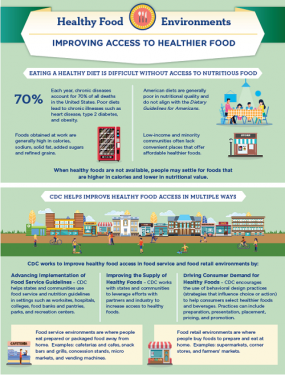Healthy Food Environments
People generally get most of their food from either food retail venues, where they buy foods to prepare and eat from home, or from food service venues, where they eat away from home. Grocery stores, corner stores, and farmers’ markets are examples of food retail venues. Restaurants (including quick serve), childcare facilities, schools, hospital and worksite cafeterias are examples of food service venues.
Having healthy food available and affordable in food retail and food service settings allows people to make healthier food choices. When healthy foods are not available, people may settle for foods that are higher in calories and lower in nutritional value. Thus, creating and supporting healthy food environments is an important part of public health work.
Many strategies can contribute to healthy food environments. These include:
- Applying nutrition standards in childcare facilities, schools, hospitals, and worksites.
- Providing incentives for supermarkets or farmers’ markets to establish their businesses in underserved areas.
- Having nutrition information and caloric content on restaurant and fast food menus.
Learn what you can do to help support people in making healthier food choices in your communities.

Hospitals and Other Worksites Can
Promote health and wellness in hospitals and other worksites. One way to do this is to implement food service guidelines, such as those developed for federal government worksites below.
- The Food Service Guidelines for Federal Facilities [PDF-3.34MB]. This assists acquisition officials, contractors, participants in the Randolph-Sheppard Vending Facility Program, and persons who monitor or advise food service operations in increasing healthy food and beverage choices and sustainable practices in federal worksites. The guidelines are designed to make healthier choices more available in cafeterias, concession stands, snack bars, and vending machines.
- The Smart Food Choices: How to Implement Food Service Guidelines in Public Facilities [PDF-3.47MB]. This is a guide with action steps to help implement food service guidelines in worksites or other public facilities. The goal is to increase the availability of healthier food and beverage options at food service venues, including cafeterias, concession stands, snack bars, and vending machines.
- The Tips For Offering Healthier Options and Physical Activity at Workplace Meetings and Events [PDF-665KB]. This publication includes suggestions and resources for increasing healthier food and beverage options at worksite meetings, parties, conferences, and events and for offering physical activity opportunities for employees throughout the workday.
- The Healthy Hospital Practice to Practice (P2P) Series. Case studies document how hospitals improved their environments to better support the health of their employees and communities and the mission of their organizations. Providing healthier food and beverage options is covered in this series.
Early Care and Education Programs Can:
Use best practices to increase consumption of healthy food and beverages and increase breastfeeding based on nutrition standards for the early care and education setting and as recommended by the Dietary Guidelines for Americans. Childcare centers can also assess their food environments and develop action plans and policies that promote healthy eating.
Helpful resources include:
- Caring for Our Children: National Health and Safety Performance Standards (CFOC), 3rd ed. This resource contains comprehensive, evidence-based national standards for this setting, including standards for obesity prevention addressing nutrition, infant feeding, physical activity, and screen time.
- Healthy Kids, Healthy Future . A website with practical tools and resources to help early care and education (ECE)providers achieve obesity prevention best practices in the following areas:
- Improving food choices
- Providing healthy beverages
- Increasing physical activity
- Reducing screen time
- Supporting breastfeeding.
- Checklist Quiz from Healthy Kids, Healthy Future helps providers assess how well they are currently meeting best practices and gives information on how to develop an action plan for making improvements. The site features information on curriculum development, menu planning, and resources for parents. A national map recognizes ECE providers who report meeting all of the best practices. A resource section for trainers also is available on the site.
- Go NAPSACC. This website provides information and resources from the Nutrition and Physical Activity Self-Assessment for Child Care (NAPSACC). Resources for children from birth to 5 years are available, plus a focus on breastfeeding and infant feeding, screen time, and outdoor play. Go NAPSACC can also tailor tools and recommendations for different childcare settings, including family childcare homes. Downloadable Go NAPSACC self-assessments are available.
- Model Child Care Health Policies (5th edition). This resource, developed by the American Academy of Pediatrics, provides guidance on the adoption of policies related to best practices on the health and safety of young children in early care and after school settings. Section 4 provides example policies related specifically to nutrition, food handling, and feeding that childcare centers can adopt for their use.
- Grow It, Try It, Like It! Nutrition Education Kit Featuring MyPlate. This is a garden-themed nutrition education kit that features fun activities in an imaginary garden. Each set of lessons contains hands-on activities, planting activities, nutrition education, and recipes to try at home.
Schools Can:
Follow nutrition standards to ensure that food and beverage options are healthy. They also can encourage students to eat foods that meet dietary recommendations for fruits, vegetables, whole grains, and nonfat or low-fat dairy products.
Other options include:
- Encourage children to drink water in place of sugary drinks and ensure access to free drinking water as an alternative to sugary drinks before, during, and after school. See Water Access in Schools [PDF-2.05MB].
- Establish salad bars to increase access to fruits and vegetables for children. See Salad Bars to Schools.
- Limit foods and drinks with added sugar, fat, and sodium that can be purchased outside the school lunch program such as in vending machines.
States and Communities Can:
- Assist in the creation of new food retail outlets in underserved areas to increase access to healthier foods and beverages.
- Support the improvement of the quality, variety, and amount of healthier foods and beverages in existing stores.
- Help with the promotion and marketing of healthier foods and beverages to consumers.
Helpful resources include:
- Healthier Food Retail: An Action Guide for Public Health Practitioners [PDF-7.71MB]. This document provides guidance on how to develop, implement, and partner on initiatives and activities to improve access, availability, and affordability of healthier foods and beverages. With this guide, public health practitioners can begin or enhance their work in healthier food retail.
- The Healthier Food Retail: Beginning the Assessment Process in Your State or Community [PDF-7.54MB]. This resource includes “how-to” information for practitioners. The document takes practitioners through a step-by-step process for conducting assessments, including focusing, planning, implementing, and communicating assessment findings.
Restaurants Can:
- Implement menu labeling, adopt nutrition standards for children’s meals, and promote healthier meals and food items. See Food and Drug Administration (FDA) Labeling Requirements for Restaurants, Similar Retail Food Establishments and Vending Machines
